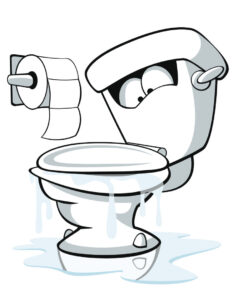
When your toilet overflows, you need to act quickly to get it under control and mitigate the damage.
Dealing with a toilet overflow can be a stressful situation, but with the right tools and know-how, you can handle it like a pro. Follow the step-by-step guide below, and you will ultimately persevere in these… less than ideal circumstances.
Turn Off the Valve
The first thing you need to do when your toilet overflows is to turn off the water shut-off valve. You can usually find it near the base of the toilet. Turn the valve until the water shuts off to prevent additional overflow. If your toilet doesn’t have a shut-off valve, open the tank and rig the float to stay in its position; this will prevent any more water from filling the tank.
Clean Up the Water
Next, you’ll have to soak up any and all water that’s spilled over the bowl and onto the floor. Use towels to clean up a small amount, or (e.g.) a Shop-Vac to help with larger spills and draw moisture out of carpet and other fabrics. It’s imperative to clean up the water as quickly as possible to prevent water damage to your bathroom floor or walls.
Disinfect Surfaces
Once you’ve got the floor dry, disinfect all surfaces in your bathroom that were dampened by or otherwise exposed to the toilet water. Use bleach and cleaning products that have antibacterial properties (like Lysol or Clorox) for a thorough disinfection. Be sure to read the container to ensure the product you choose is safe on your particular floor material, however. If you have stone floors, use something pH neutral to avoid destroying the stone surface while still getting it clean.
Clear Any Clogs
If a clog is the culprit here, you’ll have to remove it—and now’s the time. Grab a toilet plunger and try plunging it free. A sink plunger could work to some extent if you don’t have a toilet plunger, but won’t be as effective. If you have a particularly nasty clog and the previous options don’t work, you might want to try using a toilet auger (more commonly known as a “plumber’s snake”) which can reach further into the toilet and likely dislodge what your plunder couldn’t. Pouring one cup baking soda and one cup vinegar into the toilet can be an effective solution [no pun intended…]—if you can spare the eight or so hours it’ll take for the chemical breakdown to complete.) Once you’ve successfully removed the clog, go ahead and clean the toilet thoroughly before using it again.
Hire a Plumber
If all else fails, and/or you’re experiencing chronic toilet overflow, that’s a pretty good indicator you should solicit help from a professional plumber. To that end, if you’ve already determined that a clogged bowl isn’t the problem and know your septic tank has recently been cleared, it might be a more serious issue with your plumbing system, which you’ll certainly need a local plumber to assess and address. (The cost to hire a plumber is typically between $45 to $200 per hour.) On the other hand, if you suspect a full septic tank is your problem, contact a professional septic tank cleaning service near you to come by and do what they do best.
Call Mahon Plumbing Today
If you still have more questions regarding your plumbing, we here at Mahon Plumbing are here to help. We have been serving the wider Baltimore area since 1994, so we have 25 years of experience to back up our fantastic service! Call us at our Baltimore location at 410-766-8566 or our Pasadena location at 410-636-7944. Be sure to keep up with us on social media by following us on Facebook or Twitter.
